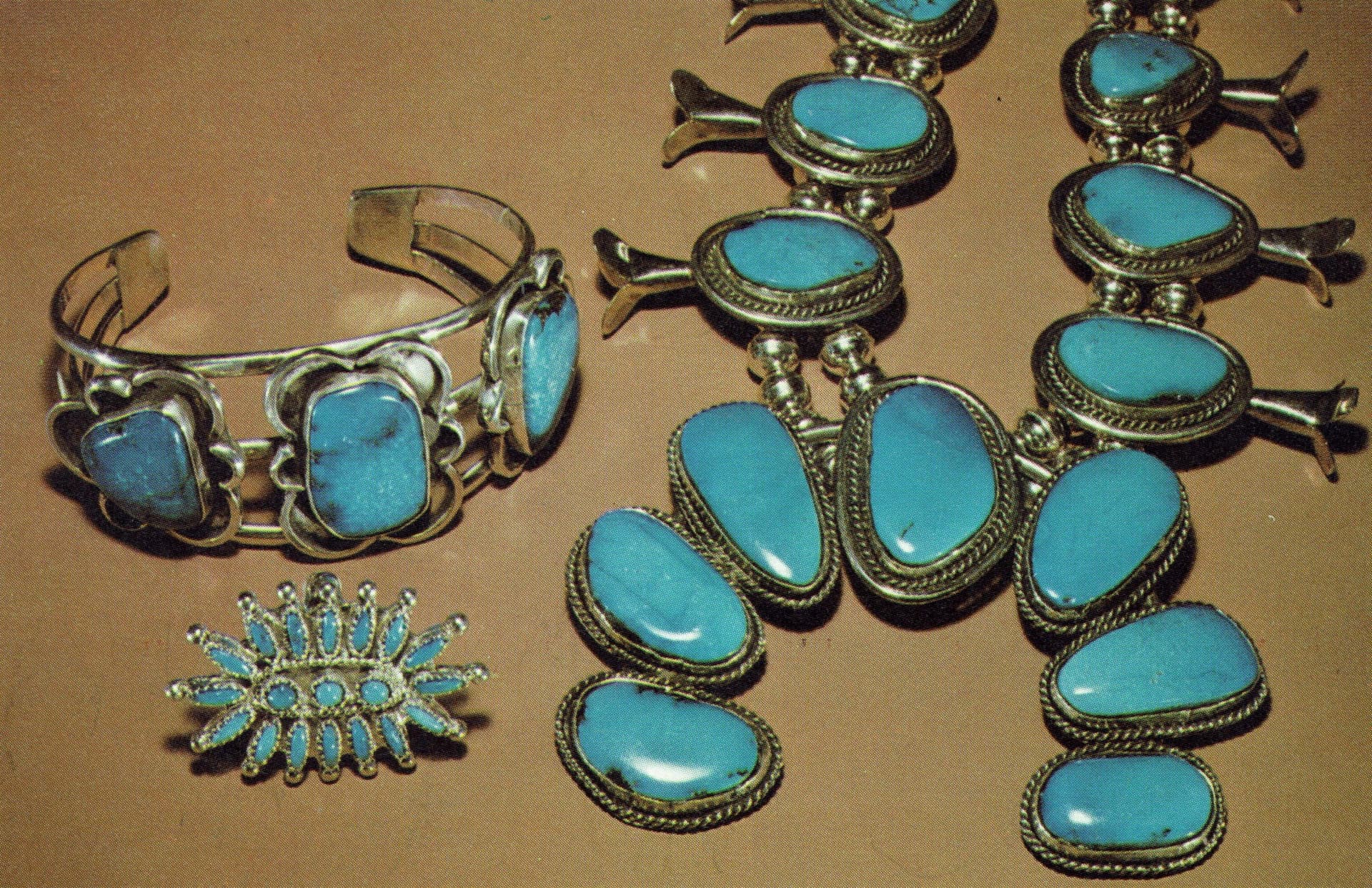Turquoise Value, Price, and Jewelry Information
With striking sky blue to blue-green colors, turquoise has been prized by cultures all over the world for over 5,000 years. Today, the traditional December birthstone is favored by well-known modern jewelry designers as well as aficionados of American Southwestern and Native American jewelry.
9 Minute Read
With striking sky blue to blue-green colors, turquoise has been prized by cultures all over the world for over 5,000 years. Today, the traditional December birthstone is favored by well-known modern jewelry designers as well as aficionados of American Southwestern and Native American jewelry.
Start an IGS Membership today
for full access to our price guide (updated monthly).Turquoise Value
In terms of value, color evenness and saturation are the primary considerations. A turquoise’s capacity for taking a good polish without stabilization is also an important factor. (See “Enhancements” below).
Generally, darker shades and less green tint in blue colors add more value to turquoises. Of course, consumers who appreciate matrix patterns would consider their beauty crucial to determining their value. Spiderweb turquoise, veined with black matrix in a pattern that looks like crocheted lace, is quite popular.
The highest grades of turquoise are used for cabochons, carvings, and inlay. Lower grades are used as polished beads or natural, “nugget-style” beads.
Turquoise enjoys an avid collector market, with sibling rivalries among the various enthusiasts who see virtue in different colors, matrix variations, and mine sites. Just as no gem collection would be complete without several representatives of this species, no jewelry collection should be without at least one piece featuring this beloved traditional December birthstone. (Turquoise is also the birthstone for those born on Saturday).
Turquoise is a real gem bargain. Even the very highest grades of material are modestly priced compared to many other gems. For more information on turquoise value factors, consult our buying guide.
Comments
Turquoise has withstood the vicissitudes of fashion as well as the passage of millennia. As early as 3,000 BCE, the Ancient Egyptians mined and worked turquoise into jewelry and ceremonial objects. Later, the Chinese and Ancient American cultures did the same. Persia (Iran) introduced Medieval Europe to this stone. Turquoise has inspired many legends and folkloric beliefs and remains a highly desired material for jewelry and decorative objects.
Although the practice of setting turquoises in silver has a long tradition in the United States, jewelers traditionally set these stones in gold, sometimes with diamonds, in the Middle East as well as Iran.
In the Victorian Era, turquoise was greatly admired and also typically set in gold. Today, more jewelry designers are emulating the Persians and Victorians and setting pieces in gold.
Although turquoises do have some physical limitations as jewelry stones, with proper cutting, treatment, and care, they can make wonderful additions to your collection.
What is Turquoise?
Chemically, turquoise is a hydrated copper/aluminum phosphate of aggregate, cryptocrystalline structure. Only one deposit is known to produce transparent to translucent crystals: Lynch Station, Virginia. (Specimens from this locale are rare and bring a hefty price from collectors). More typically, this stone occurs as an opaque deposit in nodules, in veins within host rocks, or as shallow crusts on the surface of rocks. Massive turquoise is always opaque.
The zinc analogue of turquoise, faustite has an intense yellow-green color and a density within the turquoise range. Turquoise can also form in series with the minerals chalcosiderite and planerite. Malachite and chrysocolla can sometimes grow together in stones with turquoise as well.
Turquoise Colors
Colors range from shades of blue to blue-green to yellowish green depending on the amount of trace elements. Copper adds blue. Chromium and vanadium add green. Iron adds yellow. There are rare specimens of blue-violet color which contain strontium impurities. In general, US mines produce slightly greenish blue to green gems due to high iron and vanadium content.
Historically, and even largely today, the most admired stones are those with a fine robin's egg or celestial blue color, with no visible matrix. This shade, sometimes called "Persian grade," indicates the presence of little vanadium and no iron. Iran still produces turquoises of this sort. However, the US has produced similar stones, particularly in the Sleeping Beauty Mine near Globe, Arizona.
Do Turquoise Matrix Patterns Affect Durability?
Most rough contains patches or veins of the host rock in which it formed, such as chalcedony, opal, brown limonite, black chert, or white kaolinite. Lapidaries often cut this brownish or black matrix along with the stone to provide color contrast and patterns.
This matrix can affect the color, toughness, and workability of the stone. Relatively pure specimens of turquoise might have a hardness of around 5 and be moderately porous.
In general, a high proportion of silicate minerals increases hardness and decreases porosity, while a high clay mineral content has the opposite effect. On one end of this spectrum, we find pieces of hardness 5.5 to 6 that take a bright polish and are minimally porous. On the other end, we have pieces of a soft and chalky nature so porous they're unusable without stabilization.
Identifying Characteristics
Turquoise can have a distinctive absorption spectrum, with lines at 4600 (vague) and 4320. These are usually seen in light reflected from the stone's surface.
The specific gravity (SG) of stones from different sources varies. While there is some overlap, some of the measurements at the extreme ends can help identify sources.
- Iran: 2.75-2.85
- United States: 2.6-2.7
- China: 2.70
- Eilat, Israel: 2.56-2.70
- Sinai Peninsula, Egypt: 2.81
- Tibet: 2.72
- Bahia, Brazil: 2.40-2.65
Synthetics and Simulants
Synthetic turquoise is available, with or without matrix. The Pierre Gilson Company created the most well-known type in 1972. It can resemble the finest Persian grade stone, but a microscope will reveal the difference. Natural stones have a smooth surface. Under magnification, the synthetics display a mix of tiny blue spheres in a light-colored host medium that resembles the texture of "cream of wheat."
There are many simulants on the market. Non-mineral imitations include plastics, ceramics, and glass and can appear very realistic.
Keep in mind that the color "turquoise" is very popular. Objects sold as "turquoise beads" or "turquoise jewelry" may not actually be turquoises, only turquoise-colored. Ask vendors questions or read the item descriptions carefully.
So-called "Viennese turquoise" is artificially blue-tinted argillaceous earth. (To learn more about false or misleading gemstone names, read this article).
Some natural gemstones can be mistaken for turquoise. Variscite can look like green turquoise. In fact, variscites and turquoises sometimes occur together in rocks, which are dubbed "variquoise." This attractive combination of patterns and colors can command a premium price. Proposite, especially the Mexican material with its light-blue color, is another potential simulant.
Enhancements
There are numerous enhancements for this stone. They're very difficult to detect without detailed knowledge and the right testing equipment. Pale specimens commonly receive extensive treatments to improve their color. Fine grained and compact material that will take a good polish is rare. Skin oils and cosmetic residues can easily darken the color of turquoise gems. For these reasons, most stones on the market have been enhanced in one way or another. Even top grade, otherwise natural stones often get a surface coat of paraffin wax to seal them and enhance the polish.
Stabilization
All but the highest grades of turquoise may be "stabilized" by a pressure infusion of wax or epoxy resin. Small, porous pieces are sometimes pressed together with a resin binder to make a stabilized mosaic. However, whether a stone has been stabilized is not always obvious, as the following photo illustrates.
An electro-chemical proprietary enhancement process called the "Zachery Treatment" has been promoted as an alternative to traditional stabilization that improves both durability and evenness of color.
Dyes
Turquoise itself isn't dyed frequently. However, howlite, a white and grey-veined mineral, readily accepts dye. Blue-dyed howlites often make their way to market. Unfortunately, they don't always carry "faux turquoise" labels. Sometimes, vendors sell howlite in its natural (albeit unremarkable) state under the misnomer "white turquoise." Buyer beware. There's no such thing.
Dyed magnesite can also resemble turquoise. In recent years, this material has gained popularity as a simulant. If properly disclosed, this is acceptable. If not, again, buyer beware.
Beware of "yellow turquoise" imported from China as well. Some stones do indeed have a natural light yellow-green color. However, vendors offer some very bright sunshine or butter-yellow dyed pieces without much effort to discriminate them from the non-dyed material.
Other Turquoise Treatments
- Plastic impregnation, sometimes with dye: improves durability and color, common, stable. Detect with low specific gravity, hot point, magnification.
- Wax impregnation: improves color, common, may pick up dirt and discolor. Detect with hot point, magnification.
- Epoxy impregnation: improves color slightly, makes porous material stronger and able to accept a polish, common, stable. Detect with magnification.
- Dyeing with shoe polish: enhances webbing, common, stable except to acetone. Detect by wiping with acetone.
- Epoxy backing: adds strength and weight, common, may separate. Detect by sight.
- Surface coating with epoxy, lacquer, etc: improves color, seals dye, rare, stability varies. Detect with magnification.
Please note: hot point and dye testing are destructive tests. Conduct them only as a last resort for identification.
Sources
Turquoise usually occurs in arid regions, where ground water percolates through aluminous rock in the vicinity of copper deposits. Like azurite, malachite, and opal, it's a secondary mineral that forms through the interaction of pre-existing minerals and their solutions. The majority of today's commerce in turquoise is primarily from North America and China.
Connoisseurs can tell the actual mine of origin of many cut gemstones because of distinctive nuances in color and matrix. The variation in these characteristics is enormous.
United States
The US deposits are almost exclusively limited to the Southwest, with one notable exception. (Turquoise is the official state gemstone of Arizona, Nevada, and New Mexico).
Lynch Station, Virginia
The only well-known occurrence of turquoise crystals, Lynch Station usually produces microscopic specimens. From time to time, larger ones tempt gem cutters. Some very tiny faceted gems (well under 1 carat) might exist.
Nevada
Nevada is home to more mines than Arizona, California, Colorado, and New Mexico put together.
The better known localities include the following:
- Blue Gem Mine: large variation in color, noted for blue and green colors in the same stone.
- Fox Mine: huge production; active since 1915.
- Lander Blue Mine: finely divided spiderweb, with tiny turquoise specks, rare and highly valued today.
- Stormy Mountain Mine: dark blue, hard material with black chert matrix.
Other notable mines in Nevada: Papoose, Zuni, Montezuma, Crow Springs, Carlin, Red Mountain, and Godber.
Arizona
- Bisbee: intense dark blue material, wispy matrix.
- Kingman: some deep blue material has been treated to improve color.
- Sleeping Beauty Mine: although this source no longer produces, its blue material with little matrix can be found in old collections and antique jewelry.
Other Notable Southwestern United States Sources
- Leadville (Colorado): small stones, deep blue with a tinge of green.
- Santa Rita (New Mexico): pale to deep blue colors.
Iran
Historically, mines in Persia (Iran) produced the finest material. There is still considerable production from that area. Persian, now Iranian, turquoise is almost synonymous with material of the highest quality.
District of Nishapur, on Ali-mersai Mountain: found in porphyry and trachyte rocks, cemented by brown limonite. The color is a uniform lovely sky blue, often very intense, and sometimes veined by thin lines of limonitic matrix. These mines have been worked for centuries.
China
Some mines appear to have operated in ancient times. Archaeological finds dated as early as 1,300 BCE indicate the possibility of a centuries-old exploitation of local deposits.
Currently, the Wudang mountain area of northwestern Hubei Province and Shaanxi Province, about 150 km to the northwest, produce fine turquoises. The material occurs as compact nodules, typically up to 8 cm, with much larger masses occasionally found. The color ranges from pale blue to light green. Generally, Chinese stones have softer matrix and are more porous than the material from the American Southwest.
Egypt
In the Sinai Peninsula, the Serâbît el Khâdim and Maharâh mines produce turquoise. They operated as early as 1,000 BCE, and the material was used by the Pharaohs. The producing area extends along the Suez Gulf, where the material occurs in sandstone. Earth movements have brecciated the gem and matrix. There is considerable limonite present. The color is blue to greenish blue. Some may fade in the sunlight.
Tibet
The national gem of this country, turquoise could be gathered by hand from the ground surface here. However, very little material is available today. Green is the most prized color.
Australia
Dense, compact turquoise of fine color has been found in large deposits. Found in nodules that may reach hundreds of pounds, this material is solid, takes a high polish, and is uniform in color. However, it has a slight tendency to shear along planes of weakness. The color resembles that of Persian (Iranian) turquoise.
Other Notable Sources
- Chile: the Chuquicamata copper mine has yielded material of very fine color. Not much has reached the marketplace.
- Pau a Pique, Bahia, Brazil: porous and cryptocrystalline material, RI ~ 1.618.
- Afghanistan; India; Kenya; Baja California, Sonora, and Zacatecas, Mexico; Uzbekistan.
Care
Turquoises are relatively fragile, porous, and susceptible to heat and/or chemical damage. Stones average 18-20% water content. When heated, from an unwary jeweler's torch, for example, that water is progressively lost until, at 400º C, the structural integrity of the mineral is destroyed.
Due to this stone's properties, you should reserve turquoise jewelry for occasional wear. Protect it from heat, chemicals, and shocks and use protective settings, especially for ring use.
Don't use mechanical cleaning methods, such as ultrasonic or steam cleaning. Avoid cleaning this porous gem material with soap, detergents, or cleaning solutions. Wipe with a damp cloth, then wipe dry immediately. Also, wipe pieces with a damp cloth after wearing.
For more care recommendations, consult our gemstone jewelry cleaning guide.
Joel E. Arem, Ph.D., FGA
Dr. Joel E. Arem has more than 60 years of experience in the world of gems and minerals. After obtaining his Ph.D. in Mineralogy from Harvard University, he has published numerous books that are still among the most widely used references and guidebooks on crystals, gems and minerals in the world.
Co-founder and President of numerous organizations, Dr. Arem has enjoyed a lifelong career in mineralogy and gemology. He has been a Smithsonian scientist and Curator, a consultant to many well-known companies and institutions, and a prolific author and speaker. Although his main activities have been as a gem cutter and dealer, his focus has always been education.
Donald Clark, CSM IMG
International Gem Society
Related Articles
Turquoise Buying Guide
Understanding Gem Synthetics, Treatments, And Imitations, Part 4: Synthetic Gemstone Guide
Desert Prospecting: Discovering California Turquoise
Turquoise Symbolism
Never Stop Learning
When you join the IGS community, you get trusted diamond & gemstone information when you need it.
Get Gemology Insights
Get started with the International Gem Society’s free guide to gemstone identification. Join our weekly newsletter & get a free copy of the Gem ID Checklist!





